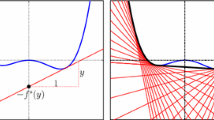Abstract
In this paper we illustrate some optimization challenges in the structured low rank approximation (SLRA) problem. SLRA can be described as the problem of finding a low rank approximation of an observed matrix which has the same structure as this matrix (such as Hankel). We demonstrate that the optimization problem arising is typically very difficult: in particular, the objective function is multiextremal even for simple cases. The main theme of the paper is to suggest that the difficulties described in approximating a solution of the SLRA problem open huge possibilities for the application of stochastic methods of global optimization.
Similar content being viewed by others
References
Abatzoglou T., Mendel J., Harada G.: The constrained total least squares technique and its applications to harmonic superresolution. IEEE Trans. Signal Process. 39(5), 1070–1087 (1991)
Chu M., Funderlic R., Plemmons R.: Structured low rank approximation. Linear Algebra Appl. 366, 157–172 (2003)
Coello Coello C.A., Lamont G.B., Van Veldhuizen D.A.: Evolutionary Algorithms for Solving Multi-objective Problems, 2nd edn, Genetic and Evolutionary Computation Series. Springer, New York (2007)
De Moor B.: Structured total least squares and L2 approximation problems. Linear Algebra Appl. 188–189(1036), 163–205 (1993)
Eckart C., Young G.: The approximation of one matrix by another of lower rank. Psychometrika 1(3), 211–218 (1936)
Gillard J.: Cadzow’s basic algorithm, alternating projections and singular spectrum analysis. Stat. Interface 3(3), 335–343 (2010)
Gillard J., Zhigljavsky A.A.: Analysis of structured low rank approximation as an optimization problem. Informatica 22(4), 489–505 (2011)
Golub G.H., Van Loan C.F.: Matrix Computations, 3rd edn, Johns Hopkins Studies in the Mathematical Sciences. Johns Hopkins University Press, Baltimore, MD (1996)
Golyandina N.: On the choice of parameters in singular spectrum analysis and related subspace-based methods. Stat. Interface 3, 259–279 (2010)
Golyandina N., Nekrutkin V., Zhigljavsky A.: Analysis of Time Series Structure: SSA and Related Techniques. Chapman & Hall/CRC, New York (2001)
Kvasov D., Sergeyev Y.: Lipschitz gradients for global optimization in a one-point-based partitioning scheme 236(16), 4042–4054 (2012)
Lemmerling P., Mastronardi N., Van Huffel S.: Efficient implementation of a structured total least squares based speech compression method. Linear Algebra Appl. 366, 295–315 (2003)
Lemmerling P., Van Huffel S.: Analysis of the structured total least squares problem for Hankel/Toeplitz matrices. Numer. Algorithms 27(1), 89–114 (2001)
Markovsky I.: Structured low-rank approximation and its applications. Automatica 44(4), 891–909 (2008)
Markovsky I.: Bibliography on total least squares and related methods. Stat. Interface 3(3), 329–334 (2010)
Markovsky I., Willems J.C., Van Huffel S., De Moor B.: Exact and Approximate Modeling of Linear Systems. SIAM, Philadelphia (2006)
Markovsky I., Willems J.C., Van Huffel S., De Moor B., Pintelon R.: Application of structured total least squares for system identification and model reduction. IEEE Trans. Automat. Control 50(10), 1490–1500 (2005)
Park H., Zhang L., Rosen J.B.: Low rank approximation of a Hankel matrix by structured total least norm. BIT Numer. Math. 39(4), 757–779 (1999)
Pruessner A., O’Leary D.P.: Blind deconvolution using a regularized structured total least norm algorithm. SIAM J. Matrix Anal. Appl. 24(4), 1018–1037 (2003)
Sergeyev Y., Kvasov D.: Global search based on efficient diagonal partitions and a set of Lipschitz constants. SIAM J. Optim. 16(3), 910–937 (2006)
Strongin R., Sergeyev Y.: Global Optimization with Non-convex Constraints. Kluwer, Dordrecht (2000)
Tufts D., Shah A.: Estimation of a signal waveform from noisy data using low-rank approximation to a data matrix. IEEE Trans. Signal Process. 41(4), 1716–1721 (1993)
Van Huffel S.: Enhanced resolution based on minimum variance estimation and exponential data modeling. Signal Process. 33(3), 333–355 (1993)
Yeredor A.: Multiple delays estimation for chirp signals using structured total least squares. Linear Algebra Appl. 391, 261–286 (2004)
Zhigljavsky A.: Theory of Global Random Search. Kluwer, Dordrecht (1991)
Zhigljavsky A., Žilinskas A.: Stochastic Global Optimization. Springer, New York (2008)
Author information
Authors and Affiliations
Corresponding author
Rights and permissions
About this article
Cite this article
Gillard, J., Zhigljavsky, A. Optimization challenges in the structured low rank approximation problem. J Glob Optim 57, 733–751 (2013). https://doi.org/10.1007/s10898-012-9962-8
Received:
Accepted:
Published:
Issue Date:
DOI: https://doi.org/10.1007/s10898-012-9962-8




